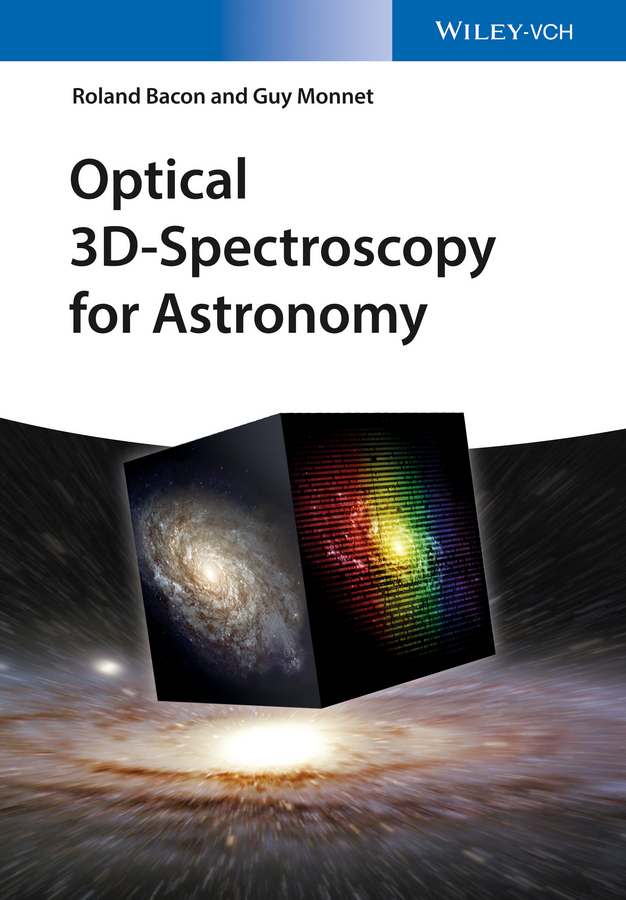
Over the last 50 years, a variety of techniques have been developed to add a third dimension to regular imaging, with an extended spectrum associated to every imaging pixel. Dubbed 3D spectroscopy from its data format, it is now widely used in the astrophysical domain, but also inter alia for atmospheric sciences and remote sensing purposes. This is the first book to comprehensively tackle these new capabilities. It starts with the fundamentals of spectroscopic instruments, in particular their potentials and limits. It then reviews the various known 3D techniques, with particular emphasis on pinpointing their different `ecological? niches. Putative users are finally led through the whole observing process, from observation planning to the extensive ? and crucial – phase of data reduction. This book overall goal is to give the non–specialist enough hands–on knowledge to learn fast how to properly use and produce meaningful data when using such a 3D capability. INDICE: Foreword xi .Acknowledgments xiii .The Emergence of 3D Spectroscopy in Astronomy 1 .Scientific Rationale 1 .3D History 4 .3D Technology 9 .Part I 3D Instrumentation 11 .1 The Spectroscopic Toolbox 13 .1.1 Introduction 13 .1.2 Basic Spectroscopic Principles 18 .1.3 Scanning Filters 20 .1.4 Dispersers 25 .1.5 2D Detectors 31 .1.6 Optics and Coatings 36 .1.7 Mechanics, Cryogenics and Electronics 45 .1.8 Management, Timeline, and Cost 50 .1.9 Conclusion 52 .2 Multiobject Spectroscopy 61 .2.1 Introduction 61 .2.2 Slitless Based Multi–Object Spectroscopy 62 .2.3 Multislit–Based Multiobject Spectroscopy 64 .2.4 Fiber–Based Multiobject Spectroscopy 70 .3 Scanning Imaging Spectroscopy 81 .3.1 Introduction 81 .3.2 Scanning Long–Slit Spectroscopy 81 .3.3 Scanning Fabry Pérot Spectroscopy 83 .3.4 Scanning Fourier Transform Spectroscopy 88 .3.5 Conclusion: Comparing the Different Scanning Flavors 91 .4 Integral Field Spectroscopy 95 .4.1 Introduction 95 .4.2 Lenslet–Based Integral Field Spectrometer 95 .4.3 Fiber–Based Integral Field Spectrometer 102 .4.4 Slicer–Based Integral Field Spectrograph 104 .4.5 Conclusion: Comparing the Different IFS Flavors 108 .5 Recent Trends in Integral Field Spectroscopy 115 .5.1 Introduction 115 .5.2 High–Contrast Integral Field Spectrometer 115 .5.3 Wide–Field Integral Field Spectroscopy 117 .5.4 An Example: Autopsy of the MUSEWide–Field Instrument 120 .5.5 DeployableMultiobject Integral Field Spectroscopy 123 .6 Comparing the Various 3D Techniques 129 .6.1 Introduction 129 .6.2 3D Spectroscopy Grasp Invariant Principle 129 .6.3 3–D Techniques Practical Differences 130 .6.4 A Tentative Rating 133 .7 Future Trends in 3D Spectroscopy 137 .7.1 3D Instrumentation for the ELTs 137 .7.2 Photonics–Based Spectrograph 138 .7.3 Quest for the Grail: Toward 3D Detectors? 144 .7.4 Conclusion 146 .7.5 For Further Reading 146 .Part II Using 3D Spectroscopy 151 .8 Data Properties 153 .8.1 Introduction 153 .8.2 Data Sampling and Resolution 153 .8.3 Noise Properties 158 .9 Impact of Atmosphere 167 .9.1 Introduction 167 .9.2 Basic Seeing Principles 168 .9.3 Seeing–Limited Observations 172 .9.4 Adaptive Optics Corrected Observations 173 .9.5 Other Atmosphere Impacts 189 .9.6 Space–Based Observations 192 .9.7 Conclusion 194 .10 Data Gathering 199 .10.1 Introduction 199 .10.2 Planning Observations 199 .10.3 Estimating Observing Time 200 .10.4 Observing Strategy 204 .10.5 At the Telescope 206 .10.6 Conclusion 209 .11 Data Reduction 213 .11.1 Introduction 213 .11.2 Basics 214 .11.3 Specific Cases 216 .11.4 Data Reduction Example: The MUSE Scheme 219 .11.5 Conclusion 236 .12 Data Analysis 237 .12.1 Introduction 237 .12.2 Handling Data Cubes 237 .12.3 Viewing Data Cubes 240 .12.4 Conclusion 241 .12.5 Further Reading 243 .13 Conclusions 245 .13.1 Conclusions 245 .13.2 General–Use Instruments 245 .13.3 Team–Use Instruments 250 .13.4 The Bumpy Road to Success 251 .References 253 .Index 269
- ISBN: 978-3-527-41202-0
- Editorial: Wiley VCH
- Encuadernacion: Cartoné
- Páginas: 296
- Fecha Publicación: 12/04/2017
- Nº Volúmenes: 1
- Idioma: Inglés
